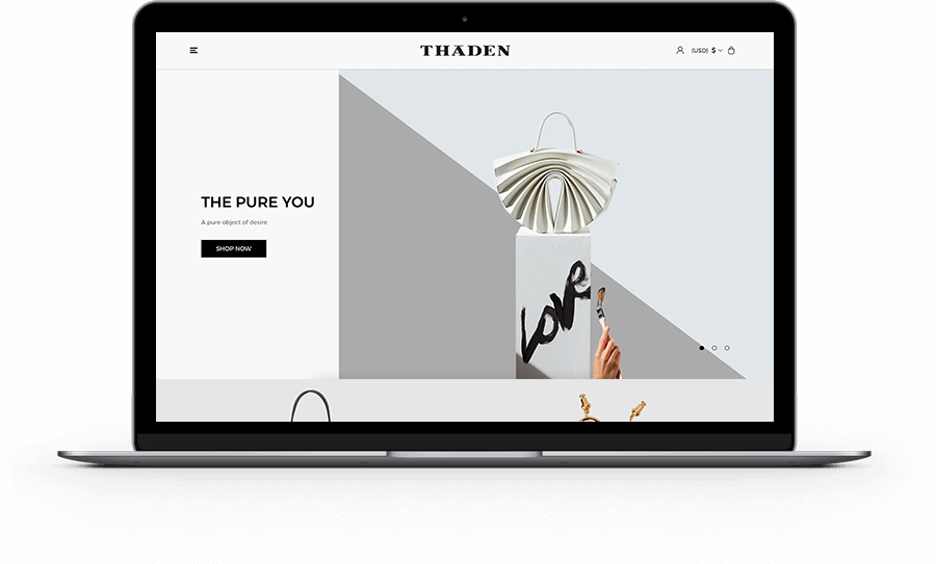The Importance of Design Thinking Strategy in 2024: 10 Compelling Reasons
I’m sure you’ve landed on a website before, and thought, “Wow” – what you’re looking at and interacting with is just a level above the rest, right?
And, I’m also sure that this is what you want for your own online presence!
Well, what if I told you that the secret sauce isn’t just about having the best tech or the flashiest features? What if I told you that it was a bit more human than that?
Introducing design thinking – where empathy, innovation, and brand design strategy come together to create magic!

But what’s all the fuss about, you ask? Imagine walking into a room filled with your users, each with their own stories, frustrations, and dreams. Design thinking is the tool that allows us to not just listen but truly understand and empathise with these stories. It’s about putting on our user’s shoes, taking a stroll, and then crafting solutions that feel like they were made just for them.
In a world where everyone’s fighting for attention, understanding your audience on a deeper level is not just smart; it’s essential. And the stats back it up — companies that embrace design thinking outperform their peers by leaps and bounds.
- According to a report by the Design Management Institute, design-led companies have outperformed the S&P index by 219% over ten years.
- Moreover, IBM found that design thinking practices can lead to a 75% reduction in project risk, a 50% reduction in time to market, and a 20% increase in team efficiency.
So, let’s explore the importance of design thinking strategy in further detail below.
What is design thinking?
At the heart of every innovative solution, there’s a process that begins and ends with the user. This process is known as design thinking.
It combines:
- Empathy for the context of a problem
- Creativity in terms of generating insights and solutions
- Rationality to analyse and fit solutions to the context
It’s a way of seeing the world and approaching challenges that isn’t confined to designers alone but is a valuable skill for everyone from CEOs to educators.
The design thinking process consists of five stages:
- Empathise – Understanding the needs, motivations, and behaviours of your users through observation and engagement.
- Define – Clearly articulating the problem you’re aiming to solve, based on insights gathered during the empathy stage.
- Ideate – Generating a wide range of ideas and solutions through brainstorming and creative thinking.
- Prototype – Building tangible representations of your ideas to explore potential solutions further.
- Test – Sharing your prototypes with users to gain feedback, learn more about the user, and refine your solution.
The outcome?
Better products
Better services
Better internal processes
Characteristics and fundamental principles of a design thinking model
Design thinking isn’t just a process; it’s a mindset, a way of looking at problems with a fresh pair of eyes. It’s about being inquisitive, empathetic, and innovative – all at the same time.
User-centricity
The user is king in the realm of design thinking. Every decision, every idea, and every prototype is created with the user’s needs and experiences in mind. It’s all about human-centred design thinking, which you can make the most of with the best creative design services.
Empathy
It all starts with empathy. By putting yourself in the users’ shoes, you gain insights into their emotions, needs, and motivations. This is crucial for crafting solutions that resonate on a personal level.
Collaboration
Design thinking thrives on diverse perspectives. It brings together people from different backgrounds and disciplines to brainstorm, critique, and iterate solutions, fostering an environment where innovation flourishes.
Experimentation
Not afraid to fail, design thinking encourages rapid prototyping and testing. It’s about learning quickly what works and what doesn’t, turning failures into stepping stones towards the ultimate solution.
Iterative process
Design thinking is never a one-and-done deal. It’s about continuously refining and improving ideas based on user feedback, ensuring the solution evolves to meet changing needs and contexts.
Design thinking frameworks and related elements
Now that we’ve unpacked the essence of design thinking, let’s dive deeper into its frameworks and related elements. These frameworks aren’t just academic concepts; they’re the blueprints that guide us in translating design thinking into tangible results.
Key frameworks in design thinking
The Double Diamond
This framework, developed by the British Design Council, comprises four phases:
Discover, Define, Develop, and Deliver
It emphasises the process of diverging and converging:
First, we open up to a broad range of possibilities (Discover and Define) and then narrow down to the most viable solutions (Develop and Deliver).
It’s like casting a wide net to explore all angles before zooming in on the solution that best meets our users’ needs.
The Five Elements of Design Thinking by Hasso-Plattner Institute of Design at Stanford
This model elaborates on the stages you’re already familiar with – Empathize, Define, Ideate, Prototype, and Test.
What stands out in this framework is its iterative nature. It shows that design thinking isn’t a linear process but a cycle of learning, experimenting, and refining.
Related elements of design thinking
Beyond the frameworks, several elements are crucial in embedding design thinking into our creative process:
- User personas – This involves creating detailed profiles of our target users to help us understand their needs, behaviours, and motivations.
- Journey mapping – This tool enables us to visualise the user’s experience with a product or service from start to finish. By identifying touchpoints and emotions throughout the journey, we can pinpoint opportunities for improvement and innovation.
- Storyboarding – This is a narrative tool that helps us to visualise the user’s interaction with our solutions. It’s a powerful way of communicating our ideas and envisioning the impact of our design choices.
- Feedback loops – Feedback loops are essential in design thinking, as they make sure we constantly learn from users and make informed adjustments. It’s all about creating a dialogue where our designs evolve based on real-world interactions and insights.
Advantages of adopting the design thinking approach
Here are 10 compelling reasons why adopting a design thinking strategy can be a game-changer for your project:
1. Enhances user satisfaction
As touched upon, you’re putting the user at the centre of the process. This means you’re going to be creating solutions that genuinely align with what your users need and expect. The outcome? Higher satisfaction and loyalty levels – just what all businesses want!
2. Fosters innovation
Design thinking encourages looking at problems from multiple angles, inviting unconventional solutions. By being open like this, you’ll land on breakthrough innovations that help your business stand out from the rest.
3. Reduces risk of failure
The iterative nature of design thinking, with its emphasis on prototyping and testing, allows teams to identify potential pitfalls early on, significantly reducing the risk of failure in the later stages of development.
4. Improves cross-functional collaboration
Design thinking brings together diverse teams. You’ll build a culture of mutual respect and collaboration. Creative potential really thrives in environments like this, driving more holistic solutions.
5. Accelerates time to market
Rapid prototyping and continuous feedback loops inherent in the design thinking principle can significantly speed up the development process, allowing organisations to move quickly from concept to launch.
6. Builds empathy and understanding
The empathise phase of design thinking helps teams build a deep understanding of their users, promoting empathy as a key driver in the design process. This empathy ensures solutions are not only functional but also resonate emotionally with users.
7. Encourages agile adaptation
Design thinking’s iterative approach makes it easier for teams to adapt to changes and pivot as necessary, ensuring the final solution remains relevant in the face of evolving user needs or market dynamics.
8. Boosts competitive advantage
Embracing design thinking propels you to the forefront of innovation. It’s like having a secret weapon that distinguishes your solutions and brands you as pioneers within your industry, making competitors play catch-up.
9. Optimises resource use
By zeroing in on actual user needs and iterating rapidly through prototyping, it ensures that every ounce of effort and material is channelled effectively, slashing waste and amplifying impact.
10. Enhances problem-solving skills
Adopting design thinking is like upgrading your team’s problem-solving toolkit. It equips them with a versatile approach to navigating through complexities with a blend of creativity and pragmatism, turning daunting challenges into manageable tasks.
Impact of design thinking on business success
The influence of design thinking cannot be underestimated! Here’s how design thinking drives business success:
- Innovation and differentiation – Design thinking nurtures a culture of innovation, helping businesses develop unique solutions that stand out in a crowded marketplace. This differentiation is key to attracting and retaining customers.
- Customer loyalty – Solutions crafted through design thinking are deeply aligned with user needs, leading to enhanced user experiences. Satisfied customers are more likely to become loyal advocates, driving repeat business and positive word-of-mouth especially when supported by a well-designed loyalty program.
- Operational efficiency – The iterative process of design thinking encourages making informed decisions quickly, reducing development time and costs. This efficiency can significantly improve a company’s bottom line.
- Adaptive strategy – The flexibility inherent in design thinking enables businesses to pivot more easily in response to market changes or new insights, ensuring they remain competitive in a fast-paced environment.
Design thinking methodology isn’t just a tool to create better products or services. It’s a strategic asset that can drive business growth, foster innovation, and build a strong, loyal customer base.
Key takeaways and recommendations
So there you have it: everything you need to know about design thinking and innovation!
- Start with empathy
- Foster a collaborative environment
- Embrace prototyping
- Cultivate an iterative mindset
- Invest in training
By adopting design thinking, you’re not just improving your products or services; you’re investing in a deeper understanding of your users and fostering a culture of innovation.
Here at Appnova, ‘design thinking’ is more than just a buzzword; it’s the heartbeat of everything we do. Whether we’re brainstorming for a start-up or reimagining the digital presence for established brands, design thinking is our north star. If you’re ready to embrace the power of design thinking, Appnova is the agency you need. Contact us today to find out more!
Subscribe To Us
Our Services
Categories
Subscribe To Us
Contributors
Categories

This website uses cookies so that we can provide you with the best user experience possible. Cookie information is stored in your browser and performs functions such as recognising you when you return to our website and helping our team to understand which sections of the website you find most interesting and useful. Third party cookies such as Google Analytics is also used on this site to provide analytics in order to better understand the user engagement on our site.
You can adjust all of your cookie settings by navigating the tabs on the left hand side.
Strictly Necessary Cookie should be enabled at all times so that we can save your preferences for cookie settings.
If you disable this cookie, we will not be able to save your preferences. This means that every time you visit this website you will need to enable or disable cookies again.







0.Comments